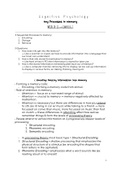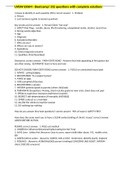C o g n i t i v e P s y c h o l o g y
Key Processes In Memory
WEEKs 10-11 → Chapter 6, 7
3 Sequential Processes to memory:
1. Encoding
2. Storage
3. Retrieval
3 Questions:
1. How does info get into the memory?
→ Like a scanner or copier, we have to encode information into a language that
our brain can understand.
2. How is that info stored & maintained in memory?
→ Like hard drives in PC's the information is stored for later use.
3. How is the stored information retrieved/pulled back out of memory?
→ Like a computer monitor, retrieving info to display, we too call up information
to display in various forms, ex: talking, thinking, moving etc
1. Encoding: Getting information into Memory
- Forming a memory code:
- Encoding = forming a memory code from stimuli.
- Role of attention in memory:
- Attention = focus on a narrowed range of stimuli
- Attention → crucial to memory → memory negatively affected by
inattention.
- Attention is necessary but there are differences in how you attend
to sth. (ex: driving in car w/ music while talking to a friend → more
focussed on convo than music, more focussed on music than foot
on clutch → these differences in attending affect how well we
remember things & form the levels of processing theory.
- People attend to verbal information at 3 progressively deeper levels of
processing:
1. Structural encoding
2. Phonemic encoding
3. Semantic encoding
- In processing theory: most basic type = Structural Encoding
1. Structural Encoding = shallow processing that emphasizes the
physical structure of a stimulus (ex: encoding the shapes that
form letters in the alphabet)
2. Phonemic Encoding = emphasizes what a word sounds like (ex:
reading aloud or to oneself.
1
, 3. Semantic Encoding = emphasizes the meaning of verbal input and
requires thinking about the content and actions that the words
represent (ex: understanding the meaning of an argument or
words in an article)
Structural, phenomic and semantic encoding do NOT cover all options of
forming memory.
Ways to improve encoding:
1. Elaboration - linking stimulus to other info at time of encoding,
often involves linking examples and self coding examples work
best (ex: studying phobias for psychology, relate this to your own
fear of spiders)
2. Visual Imagery - imagery or creation of visual imagery to
represent words (much easier to visualize concrete words (‘jugular’
easier to visualize than ‘truth’)
Dual coding theory = memory is enhanced by forming semantic or
visual codes (either can lead to recall)
3. Self-referent encoding = involves deciding how or whether
information is personally relevant (information that is personally
meaningful is more relevant to us) /making materials personally
meaningful
4. Motivation to remember = higher motivation at time of encoding
leads to greater recall.
2. Storage: Maintaining Information in Memory
Sensory Memory / Short-term Memory / Long-Term Memory
Information Processing Theories:
- Different models of memory
- How do we organise and store information over time? Answered by
→ Atkinson and Shiffrin’s memory model
- Atkinson & Shiffrin proposed memory is made up of 3 memory
storages:
- Not to actually be viewed as anatomical structures in the brain,
but rather a metaphor for functionally distinct types of memory.
2
Key Processes In Memory
WEEKs 10-11 → Chapter 6, 7
3 Sequential Processes to memory:
1. Encoding
2. Storage
3. Retrieval
3 Questions:
1. How does info get into the memory?
→ Like a scanner or copier, we have to encode information into a language that
our brain can understand.
2. How is that info stored & maintained in memory?
→ Like hard drives in PC's the information is stored for later use.
3. How is the stored information retrieved/pulled back out of memory?
→ Like a computer monitor, retrieving info to display, we too call up information
to display in various forms, ex: talking, thinking, moving etc
1. Encoding: Getting information into Memory
- Forming a memory code:
- Encoding = forming a memory code from stimuli.
- Role of attention in memory:
- Attention = focus on a narrowed range of stimuli
- Attention → crucial to memory → memory negatively affected by
inattention.
- Attention is necessary but there are differences in how you attend
to sth. (ex: driving in car w/ music while talking to a friend → more
focussed on convo than music, more focussed on music than foot
on clutch → these differences in attending affect how well we
remember things & form the levels of processing theory.
- People attend to verbal information at 3 progressively deeper levels of
processing:
1. Structural encoding
2. Phonemic encoding
3. Semantic encoding
- In processing theory: most basic type = Structural Encoding
1. Structural Encoding = shallow processing that emphasizes the
physical structure of a stimulus (ex: encoding the shapes that
form letters in the alphabet)
2. Phonemic Encoding = emphasizes what a word sounds like (ex:
reading aloud or to oneself.
1
, 3. Semantic Encoding = emphasizes the meaning of verbal input and
requires thinking about the content and actions that the words
represent (ex: understanding the meaning of an argument or
words in an article)
Structural, phenomic and semantic encoding do NOT cover all options of
forming memory.
Ways to improve encoding:
1. Elaboration - linking stimulus to other info at time of encoding,
often involves linking examples and self coding examples work
best (ex: studying phobias for psychology, relate this to your own
fear of spiders)
2. Visual Imagery - imagery or creation of visual imagery to
represent words (much easier to visualize concrete words (‘jugular’
easier to visualize than ‘truth’)
Dual coding theory = memory is enhanced by forming semantic or
visual codes (either can lead to recall)
3. Self-referent encoding = involves deciding how or whether
information is personally relevant (information that is personally
meaningful is more relevant to us) /making materials personally
meaningful
4. Motivation to remember = higher motivation at time of encoding
leads to greater recall.
2. Storage: Maintaining Information in Memory
Sensory Memory / Short-term Memory / Long-Term Memory
Information Processing Theories:
- Different models of memory
- How do we organise and store information over time? Answered by
→ Atkinson and Shiffrin’s memory model
- Atkinson & Shiffrin proposed memory is made up of 3 memory
storages:
- Not to actually be viewed as anatomical structures in the brain,
but rather a metaphor for functionally distinct types of memory.
2



